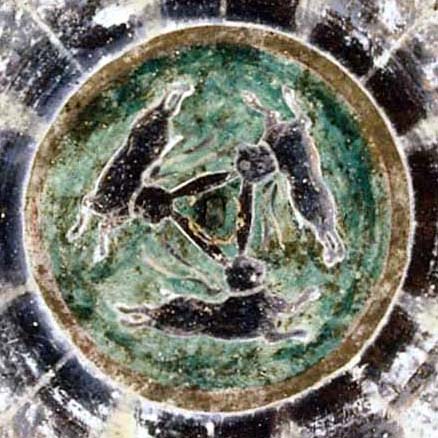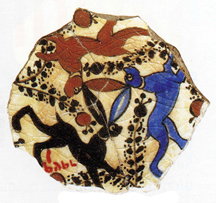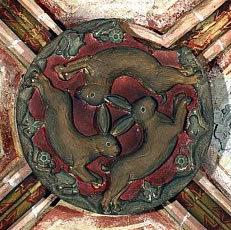Three hares are chasing one another in an everlasting circle. They share between them only three ears which form a triangle in the center of the design, yet each animal has two ears. The earliest known appearance of this motif is in the Mogao caves near Dunhuang in northwest China, which were created during the Sui to Tang dynasties (581-907 AD). Along the Silk Road other sightings of the three hares (and sometimes four hares) are found. The hares seem to have traveled in distance and time, adapting to different religions and taking on new meanings where they settled. Recently researchers have begun seeking to answer these questions:
- What is the meaning of the three hares motif?
- Where did the motif originate?
- How did it spread?
Together with other scholars and researchers, the Classical Chinese Puzzle Project and The Three Hares Project have been involved in studying the history, meaning and journey of the three hares motif. This website is dedicated to stimulating discussion and further research on the three hares.
Related Websites and Links
- The Three Hares in China. Here are some of the earliest known images of the three hares motif from the ceilings of Buddhist caves at Dunhuang in northwest China together with related examples from Tibet and Ladakh.
- The Three Hares Project has documented all known occurrences of the three hares motif in Devon and the rest of Britain. Many of photographer Chris Chapman's beautiful images of the hares are included on this website.
- Chasing Hares. Writer and historian James Crowden follows three historical detectives from a church in Devon to a high mountain kingdom in the Himalayas searching for the meaning and origin of the ancient symbol of the three hares. BBC Radio Program.
Contact Us
ChinesePuzzles.org
Sponsored by the Classical Chinese Puzzle Project
with help from The Three Hares Project.
Special thanks to Tim Hunt.
 Cave 407, Dunhuang, China.
Cave 407, Dunhuang, China.Sui dynasty (589-618 AD).

Pottery Fragment.
Egypt or Syria, ca.1200.

Roof Boss, Church of St. Peter and Paul,
Wissembourg, France, ca.1300.
©Chris Chapman 2004